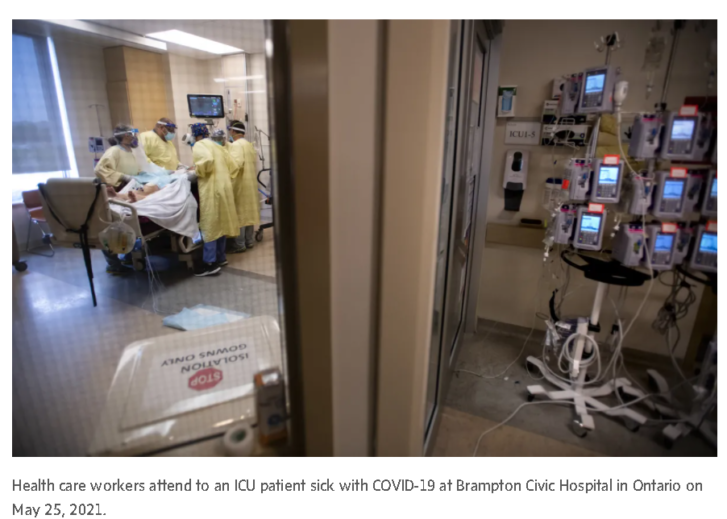Ontario’s COVID-19 cases are rising in most public health units across the province, with hospitalizations and intensive-care occupancy remaining stable but ICUs likely to rise, according to new modelling.
The province’s COVID-19 science and modelling advisory tables released new projections on Friday which state that those with lower incomes, essential workers, and minority groups are at highest risk of COVID-19-related mortality. The inequity stems from differential exposures and barriers in access to testing and isolation, the modelling says.
The data show vaccinations continue to be highly effective in combatting COVID-19, with unvaccinated people 17 times more likely to be hospitalized and having a 23-fold higher risk of being in the ICU compared to the fully vaccinated.
With case counts rising, “the immediate future is uncertain,” because the current surge is very recent, the document says. Colder weather causing people to spend more time indoors, the lifting of capacity limits in most venues across the province and indoor gatherings are cited as the sources of recent transmission.
Hospitalizations and intensive care occupancy have fallen significantly from a peak in the spring, but the modelling warns they are likely to rise again. On Friday, 207 people were hospitalized with COVID-19, with 130 people in ICU – 121 of whom are not fully vaccinated or have an unknown vaccination status. Modelling shows that ICU numbers could climb to between 200 and 250 people by the end of December.

While previous projections from October showed cases declining, the trend has now reversed. Ontario Chief Medical Officer Kieran Moore said this week that the province is seeing an increase in key indicators such as the effective reproductive number, the per cent of tests that are positive and weekly case rates, which are up 30 per cent. The province on Friday reported 598 new cases of COVID-19. Ontario continues to have one of the lowest case rates in the country.
The spread is happening mostly in the 20-to-39 age group in social settings indoors, Dr. Moore said.
The government this week announced that Ontario is pausing further reopening for at least 28 days and delaying lifting capacity limits in higher-risk settings such as nightclubs, wedding receptions with dancing and strip clubs. Other settings, such as sports venues, restaurants and bars, remain at full capacity.
In their latest brief, the science table says “a deliberate pause on re-opening is the right decision at this time. Policies that support wearing masks properly indoors and getting fully vaccinated will be helpful.”
Ontario has implemented a vaccine-passport system but the government has announced that it plans to gradually lift proof of vaccination requirements beginning on Jan. 17, “in the absence of concerning trends in public health.” Remaining public health measures, such as masking in indoor public spaces, will be lifted beginning on March 28, the government previously announced.
Alex Hilkene, a spokeswoman for Health Minister Christine Elliott, said that Friday’s modelling “supports Ontario’s cautious and gradual plan for reopening,” including the decision to pause the lifting of capacity limits next week.
“There’s no question that the months ahead will require continued vigilance, and the modelling rightly points out that some jurisdictions are struggling as they continue to face the fourth wave of COVID-19,” she said. “That’s why Ontario continues to take a different approach by maintaining strong public health measures such as indoor masking and proof of vaccination requirements to access higher-risk settings.”
Meanwhile, the province on Friday announced that 98 per cent of staff in long-term care homes have now received at least one dose of the COVID-19 vaccine, and 95 per cent are fully vaccinated. Staff and volunteers have until Nov. 15 to provide proof of one dose, and until Dec. 13 to provide proof of two doses, in order to enter long-term care homes in the province. The previous deadline for full vaccination was Nov. 15 but the province said it was pushed back based on recent advice from the National Advisory Committee on Immunization, which now recommends eight weeks between doses.
Article From: Globe and Mail
Author: LAURA STONE

